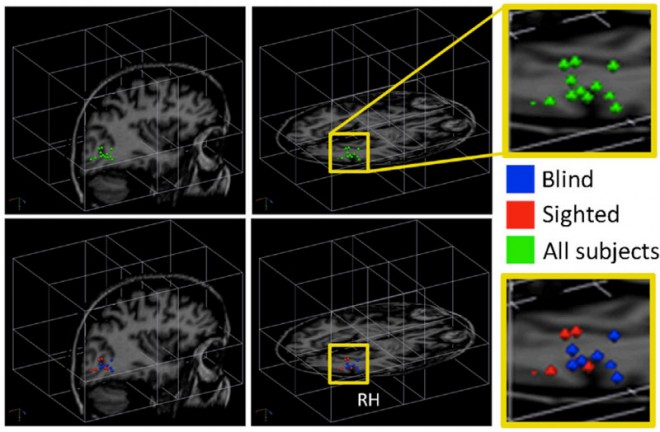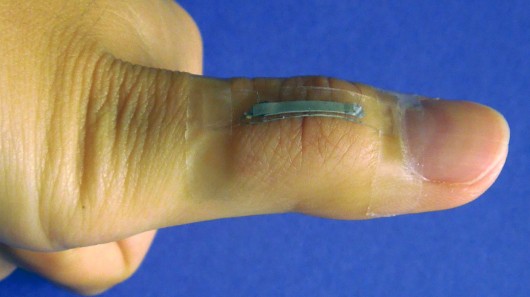Category: Assistive Technologies
-

“Brain controlled” exoskeleton boosts limb power
“Hybrid Assistive Limb” or “HAL” is an exoskeleton by Cyberdyne that detects electrical pulses on the skin when one’s brain sends a “move” message to a limb. The robotic suit recognizes the intended motion, and then moves “naturally” with the arm or leg, providing additional power.
-

Visual cortex activated by audio stimuli
Current Biology | Wired Hebrew University professor Amir Amedi has used an augmented reality device to allow the blind to “see” by converting images to complex sounds. The user is able to form a mental image of objects, including people, in front of them. The cerebral cortex is activated when sighted people see an outline…
-

Crowdfunded, gesture controlled, bluetooth ring
Kickstarter campaign Logbar‘s sensor ring recognizes finger gestures and controls devices. “Ring” allows the wearer to write text messages by drawing in the air, make mobile payments, or control lights or a television. It is being tested for use with the Pebble watch, quadcopter drones and Google Glass. It can be programmed to respond to original shape gesture…
-

Non-invasive, nanoparticle method for identifying atherosclerosis plaques
http://pubs.acs.org/doi/abs/10.1021/nl404816m Case Western‘s Michael Bruckman and colleagues have developed a multifunctional nanoparticle that pinpoints blood vessel plaques caused by atherosclerosis using MRI. The goal is to create a non-invasive method of identifying heart attack and stroke causing plaques vulnerable to rupture, in time for treatment. Currently doctors can only identify narrowing blood vessels caused by plaque…
-
Minimally invasive multi-channel control system for prosthetics tested
http://www.multivu.com/mnr/65112-alfred-mann-foundation-u-s-marine-subject-fda-study-for-imes-system The Alfred Mann Foundation‘s first subject, a U.S. Marine, will receive its IMES System (implantable myoelectric sensor). The experimental system could be the first minimally invasive, intuitive, multi-channel control system for prosthetics, intended for long term use. It is being studied under the Investigational Device Exemption regulations of the U.S. Food and Drug…
-

Wearable, multifunctional, silver nanowire sensor for prosthetics, robotics
http://pubs.rsc.org/en/Content/ArticleLanding/2014/NR/C3NR05496A#!divAbstract North Carolina State University researchers have developed a thumb joint mounted, multifunctional sensor using silver nanowires that measures strain, pressure, human touch and bioelectronic signals. With potential biomedical, military and athletic applications, the sensor can be used for prosthetics, robotic systems and flexible touch panels. “The technology is based on either physical deformation or…
-
Paraplegic may kick off 2014 FIFA World Cup using brain controlled exoskeleton
http://www.copa2014.gov.br/en/noticia/brazilian-neuroscientist-miguel-nicolelis-unveil-walk-again-project-fifa-world-cup-brazil Duke Professor Miguel Nicolelis‘s brain controlled exoskeleton technology may enable a paraplegic teen to kick off the 2014 World Cup in Brazil. The plan is for the teenager to walk onto the field, cock back a foot, and swing at a soccer ball, using a mechanical exoskeleton controlled by his/her brain. Motorized metal braces tested…
-
Johns Hopkins develops thought controlled prosthetic arm and “targeted innervation” technique
http://hub.jhu.edu/2013/01/02/prosthetic-arm-60-minutes The number of researchers developing advanced prosthetics, particularly thought controlled limbs, is increasing rapidly. This can significantly impact the lives of many. In Johns Hopkins Universty’s Applied Physics Lab, a motorized arm with a five fingered hand that operates much like human hand is nearing completion. Professor Michael McLoughlin and trauma surgeon Albert Chi have developed a…
-
Nerve interface simulates touch in prosthetic hand
http://www.technologyreview.com/news/522086/an-artificial-hand-with-real-feelings/ Cleveland Veterans Affairs Medical Center and Case Western Reserve University researchers have developed an interface that can convey a sense of touch from 20 spots on a prosthetic hand. It directly stimulates nerve bundles, known as peripheral nerves, in the arms of patients. Two people have been fitted with the interface to date.…
-
Nerve impulse sensor exoskeleton assists paraplegics, Parkinson’s, stroke patients
http://www.dw.de/standing-again-with-nerve-controlled-robotics/a-17280419 Professor Thomas Schildhauer leads a team at Bergmannsheil University Clinic’s “Center for Neuro-Robotic Mobility Training” that uses nerve impulse sensors to help patients walk again. A robotic exoskeleton with sensors affixed to the hips and legs gives paraplegics, Parkinson’s and stroke patients a sense of stability during ambulatory exercises. The robot suit contains numerous sensors that…
-
Tongue based magnetic field controls wheelchair
http://stm.sciencemag.org/content/5/213/213ra166 Maysam Ghovanloo of Georgia Tech and Anne Laumann of Northwestern have developed a tongue piercing based magnet to operate a wheelchair. The device is a small magnetic barbell which creates a magnetic field in the mouth. When users flick their tongues, it alters that field. The change is picked up by four small sensors…
-
Monkeys in Nicolelis lab control both arms using brain activity
http://stm.sciencemag.org/content/5/210/210ra154.short?rss=1 Duke’s Miguel Nicolelis continues to advance brain machine interface, and in his latest experiment, monkeys have learned to control the movement of both arms on an avatar using their brain activity. The findings advance efforts to develop bilateral movement in brain-controlled prosthetic devices for severely paralyzed patients. Until now brain-machine interfaces could only control…